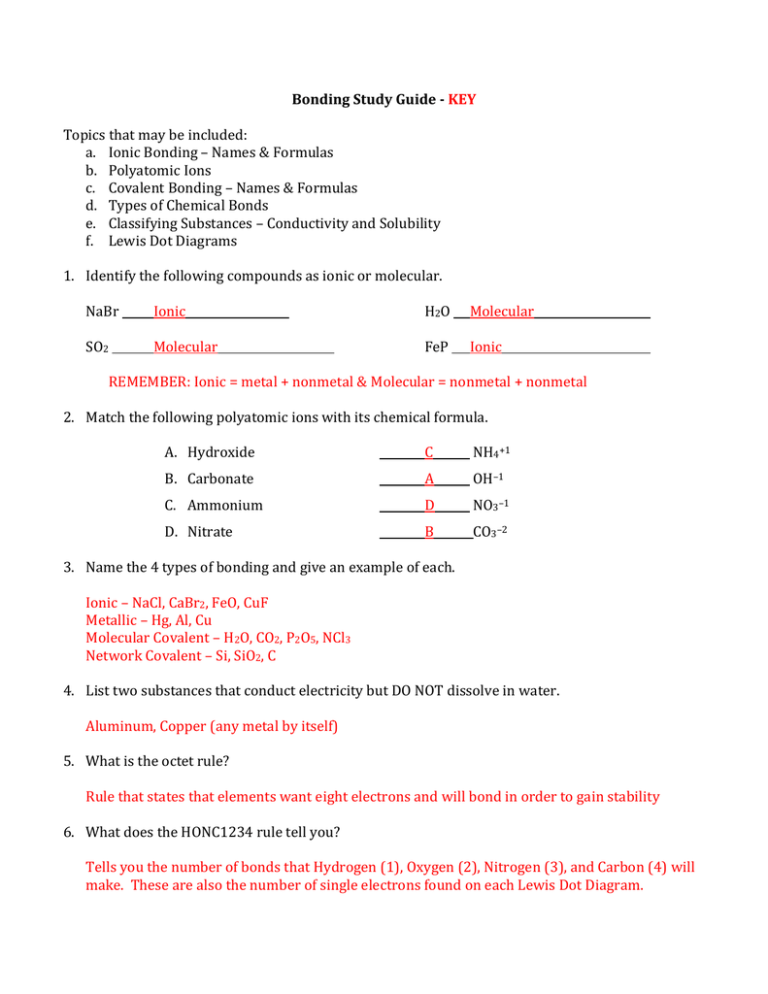Bonding Study Guide - KEY Topics that may be included: Ionic
advertisement

Bonding Study Guide - KEY Topics that may be included: a. Ionic Bonding – Names & Formulas b. Polyatomic Ions c. Covalent Bonding – Names & Formulas d. Types of Chemical Bonds e. Classifying Substances – Conductivity and Solubility f. Lewis Dot Diagrams 1. Identify the following compounds as ionic or molecular. NaBr Ionic H2O Molecular SO2 Molecular FeP Ionic REMEMBER: Ionic = metal + nonmetal & Molecular = nonmetal + nonmetal 2. Match the following polyatomic ions with its chemical formula. A. Hydroxide C NH4+1 B. Carbonate A OH–1 C. Ammonium D NO3–1 D. Nitrate B CO3–2 3. Name the 4 types of bonding and give an example of each. Ionic – NaCl, CaBr2, FeO, CuF Metallic – Hg, Al, Cu Molecular Covalent – H2O, CO2, P2O5, NCl3 Network Covalent – Si, SiO2, C 4. List two substances that conduct electricity but DO NOT dissolve in water. Aluminum, Copper (any metal by itself) 5. What is the octet rule? Rule that states that elements want eight electrons and will bond in order to gain stability 6. What does the HONC1234 rule tell you? Tells you the number of bonds that Hydrogen (1), Oxygen (2), Nitrogen (3), and Carbon (4) will make. These are also the number of single electrons found on each Lewis Dot Diagram. 7. Why does salt conduct electricity ONLY when dissolved in water? Salt = NaCl (sodium chloride) Before dissolving in water: The sodium and chlorine atoms are bonded together. This stops electricity from flowing through. After dissolving in water: The bonds are broken and salt break apart into its ions (Na+1 & Cl-1). The positive and negative charges allow electricity to flow through. 8. In what type of compounds are electrons transferred? In what type of compounds are electrons shared? Transferred = ionic compounds (ionic bonds) Shared = molecular compounds (covalent bonds) 9. How do you know when to use a roman numeral when naming a compound? Roman numerals are required when using a transition metal because these elements can have multiple charges. For example, copper can be +1 or +2. The Roman numeral tells you which charge you are using. 10. Give the name or formula of the following chemical compounds. Name Sodium iodide Sulfur dioxide Iron (III) oxide Calcium chloride Carbon tetrafluoride Phosphorus pentachloride Potassium hydroxide Formula NaI SO2 Fe2O3 CaCl2 CF4 PCl5 KOH Helpful Hints: 1. Ionic and molecular compounds have different rules for naming and writing formulas. Determine if it’s a metal + nonmetal or nonmetal + nonmetal first. 2. Molecular compounds need prefixes (mono, di, tri, etc.) 3. Ionic compounds use ions when writing the formula. Check your periodic table for the correct charges. No prefixes! 4. Transition metals require a roman numeral. 5. If you see more than 2 total elements in the compound = there is a polyatomic ion




